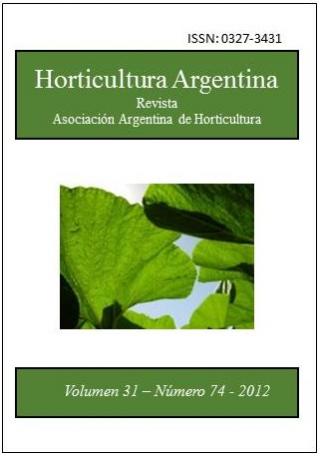Ver ítem
- xmlui.general.dspace_homeCentros e Institutos de InvestigaciónCIRN. Centro de Investigaciones de Recursos NaturalesInstituto de FloriculturaArtículos científicosxmlui.ArtifactBrowser.ItemViewer.trail
- Inicio
- Centros e Institutos de Investigación
- CIRN. Centro de Investigaciones de Recursos Naturales
- Instituto de Floricultura
- Artículos científicos
- Ver ítem
Zinnia peruviana (L.) L.: Selección de germoplasma con buen comportamiento bajo riego con aguas grises = Selection of germoplasm with good behavior with greywater irrigation
Resumen
En Capilla del Monte próximamente existirá legislación instruyendo
a la recuperación de las aguas domiciliarias. Parte de las
especies para sistemas remediantes de climas fríos presentan escasas
variaciones en sus cualidades estéticas, dificultando el diseño
del paisaje. Zinnia peruviana es ornamental, soporta drenaje
impedido y podría intersembrarse entre aquellas. Se hipotetizó que
en las poblaciones locales silvestres de Z. peruviana existen
[ver mas...]
En Capilla del Monte próximamente existirá legislación instruyendo
a la recuperación de las aguas domiciliarias. Parte de las
especies para sistemas remediantes de climas fríos presentan escasas
variaciones en sus cualidades estéticas, dificultando el diseño
del paisaje. Zinnia peruviana es ornamental, soporta drenaje
impedido y podría intersembrarse entre aquellas. Se hipotetizó que
en las poblaciones locales silvestres de Z. peruviana existen individuos
con buen comportamiento bajo riego con aguas grises. El
objetivo del experimento fue identificar y seleccionar germoplasma
de Z. peruviana capaz de crecer y desarrollarse satisfactoriamente
en envases cerrados, regados con agua de un lavadero
domiciliario. Las plantas recibieron agua potable (0 o Testigo), o
de lavadero (I) 90 mL, día por medio, en ambos casos. La supervivencia
y el crecimiento en plantas jóvenes no mostraron efectos
de los tratamientos. En el estado adulto se hallaron plantas significativamente
más altas y con mayor número de hojas, de capítulos
y de brotes axilares en el Testigo. Las diferencias se adjudicaron
a la prolongada exposición al tratamiento I o a la superior sensibilidad
en estado reproductivo. No obstante ello, se pudo seleccionar
cuatro plantas que se diferenciaron por ser aptas para cumplir
su ciclo con el tratamiento de aguas grises y por mostrar fenotipos
comercialmente satisfactorios que se explican por la presencia
de información genética que les permitió admitir el tratamiento
I.
[Cerrar]
In Capilla del Monte there would be soon legislation instructing
household water recovery. Some of the species of remedial systems
for cold climates show few variations in their aesthetic qualities,
making it difficult to design the landscape. Zinnia peruviana
is ornamental, tolerates impeded drainage and could be interseeded
among those. It has been hypothesized that in the local wild populations
of Z. peruviana there are individuals with good
[ver mas...]
In Capilla del Monte there would be soon legislation instructing
household water recovery. Some of the species of remedial systems
for cold climates show few variations in their aesthetic qualities,
making it difficult to design the landscape. Zinnia peruviana
is ornamental, tolerates impeded drainage and could be interseeded
among those. It has been hypothesized that in the local wild populations
of Z. peruviana there are individuals with good behavior
under irrigation with greywater. The aim of the experiment was to
identify and select germplasm of Z. peruviana able to grow and
develop successfully in closed containers, irrigated with water
from a household laundry. The plants received 90 mL of drinking
water (0 or Testigo), or laundry water (I) every other day, in both
cases. The survival and growing of the young plants showed no
treatment effects. In the fully grown state they found plants significantly
higher and with a greater amount of leaves, blossoming
tops and axillary shoots in the Testigo. The differences were associated
with prolonged exposure to the treatment I or higher sensitivity
in reproductive state. However they could select four plants
that stood out to be suitable for fulfilling its cycle with the greywater
treatment and show commercially satisfactory phenotypes
which can be explained by the presence of genetic information
which allow them to accept treatment I.
[Cerrar]

Autor
Fatta, Nora Alicia;
Vasallo, S.A.;
Papone, Mirta Leonor;
Fuente
Horticultura argentina 31 (74) : 5-14. (Ene.-Abr. 2012)
Fecha
2012
Editorial
Asociación Argentina de Horticultura
ISSN
0327-3431
1851-9342 (Online)
1851-9342 (Online)
Formato
pdf
Tipo de documento
artículo
Palabras Claves
Derechos de acceso
Abierto
 Excepto donde se diga explicitamente, este item se publica bajo la siguiente descripción: Creative Commons Attribution-NonCommercial-ShareAlike 2.5 Unported (CC BY-NC-SA 2.5)
Excepto donde se diga explicitamente, este item se publica bajo la siguiente descripción: Creative Commons Attribution-NonCommercial-ShareAlike 2.5 Unported (CC BY-NC-SA 2.5)


